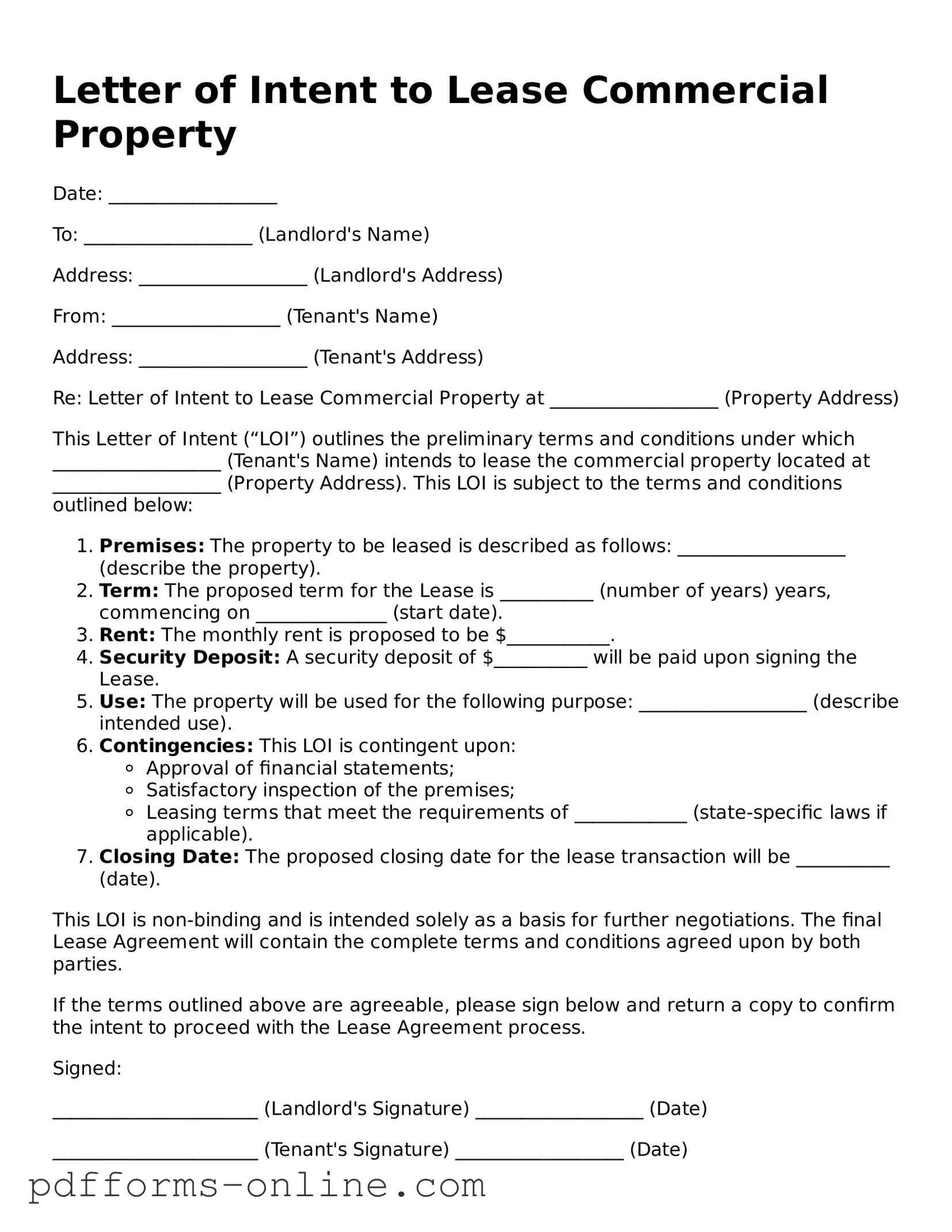The Letter of Intent (LOI) to Lease Commercial Property is similar to a Memorandum of Understanding (MOU). Both documents outline the preliminary agreements between parties before finalizing a contract. An MOU serves to clarify the intentions of the involved parties and can cover various aspects of a potential relationship, including terms and conditions. While an LOI focuses specifically on lease terms, an MOU may address broader topics, making it a useful tool for establishing mutual understanding before more detailed negotiations begin.
A Term Sheet is another document comparable to the LOI. Typically used in business transactions, a Term Sheet summarizes the key points of a deal. In the context of leasing, it highlights essential lease terms such as rent, duration, and responsibilities of each party. While the LOI may serve as a precursor to a formal lease agreement, a Term Sheet often functions as a starting point for negotiations, ensuring that all parties are aligned on the main aspects before drafting the final contract.
The Lease Agreement itself is a more formal document that follows the LOI. This legally binding contract details the specific rights and obligations of both the landlord and tenant. While the LOI outlines the intent to lease and basic terms, the Lease Agreement includes comprehensive provisions regarding payment schedules, maintenance responsibilities, and termination clauses. The transition from LOI to Lease Agreement signifies a commitment to the terms discussed and often involves legal review.
A Purchase and Sale Agreement (PSA) shares similarities with the LOI in that it outlines the intentions of the parties involved in a real estate transaction. While a PSA is focused on the sale of property rather than leasing, both documents serve as preliminary agreements that set the stage for more detailed contracts. Each document establishes the framework for negotiations, ensuring that all parties understand the basic terms before proceeding to more formal arrangements.
An Offer to Lease is closely related to the LOI, as both documents express the desire to enter into a lease agreement. An Offer to Lease typically includes specific terms proposed by the prospective tenant, such as rental rate and lease duration. The landlord can accept, reject, or negotiate these terms, making the Offer to Lease a crucial step in the leasing process. Like the LOI, it sets the groundwork for further discussions and eventual contract formation.
For those considering homeschooling in Colorado, the process begins with the important step of submitting a https://hsintentletter.com/, as this letter serves to formally inform the local school district of a parent's intent to educate their child at home, aligning with state requirements and ensuring a smooth transition into this educational pathway.
A Non-Disclosure Agreement (NDA) can also be considered similar in its purpose of protecting sensitive information during negotiations. While the LOI outlines the intent to lease, an NDA ensures that any proprietary or confidential information shared during discussions remains protected. Both documents facilitate open communication and trust between parties, which is essential for successful negotiations. An NDA is particularly important in commercial real estate, where financial and strategic information may be disclosed.
A Letter of Understanding (LOU) is another document that parallels the LOI. An LOU serves to confirm the understanding between parties regarding key terms and conditions of a proposed agreement. Like the LOI, it is not legally binding but provides clarity on the intentions of the parties involved. This document can be particularly useful in complex leasing situations where multiple terms need to be clarified before entering into a formal agreement.
Finally, a Business Proposal may resemble the LOI in that it outlines the intentions and expectations of a party looking to enter into a business relationship. While a Business Proposal focuses on the benefits and terms of a proposed project or partnership, the LOI specifically addresses the terms of leasing commercial property. Both documents are instrumental in initiating discussions and can help to align the interests of the parties involved, paving the way for more detailed negotiations.
